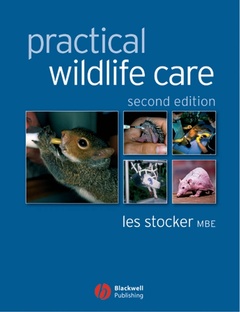Practical Wildlife Care (2nd Ed.)
Auteur : Stocker Les

Following on from the major success of the first edition, this second edition provides even more useful information on wildlife care and rehabilitation. As well as covering a whole range of species, with sections on birds, mammals, reptiles and amphibians, this edition now includes information on many ?alien? species appearing in the British countryside such as wallabies, wild boar and exotic reptiles.
In this edition:
- Essential guidance on handling, first aid, feeding and releasing, and many other disciplines not featured in veterinary or nursing training
- Full of helpful tips from an expert in wildlife rehabilitation who has unparalleled practical experience
- Expanded chapters on the care of all species ? particularly casualty badgers, otters and hedgehogs ? and more comprehensive guidance on rearing orphaned mammals and birds
- Lots more colour pictures to aid in management and care techniques and the latest information on zoonotic diseases from around the world
Preface.
Acknowledgements.
1 Prime Directives.
2 First Response.
3 Fluid Therapy / Part I: Building Blocks.
4 Fluid Therapy / Part II: Administration.
5 Wound Management / Part I: The Biology of Wounds.
6 Wound Management / Part II: The Treatment of Wounds.
7 Biology and First Aid of Fractures.
8 Fracture Management.
9 Avian Wildlife Disease.
10 Mammalian Wildlife Disease.
11 Garden Birds.
12 Pigeons.
13 Game Birds.
14 Corvids.
15 Water Birds – Ducks.
16 Water Birds – Swans.
17 Geese and Other Water Birds.
18 Birds of Prey.
19 Seabirds.
20 Hand-rearing Orphaned Birds.
21 Small Mammals.
22 Hedgehogs.
23 Rabbits and Hares.
24 Red Fox.
25 Badgers.
26 Other Mustelids.
27 Deer.
28 Bats.
29 Other Mammal Species.
30 Rearing Orphaned Wild Mammals.
31 Reptiles and Amphibians.
Appendix 1 JNCC Guidelines on Handling Bats.
Appendix 2 British Divers Marine Life Rescue (BDMLR) Guidelines for Response to Cetacean Strandings.
Appendix 3 Birds on Schedule 4 of the Wildlife and Countryside Act 1981 (as of May 1998).
Appendix 4 The Law relating to the use and possession of airguns.
Appendix 5 Suggested Record Sheet to Accompany Bat Samples to the Central Veterinary Laboratory.
Appendix 6 Selected Rehabilitation Supplies and Suppliers.
Appendix 7 Useful Addresses in Wildlife Rehabilitation.
References and Further Reading.
Index.
Date de parution : 09-2005
Ouvrage de 352 p.
18.3x23.9 cm
Thème de Practical Wildlife Care :
Mots-clés :
rehabilitation; time; onetoone basis; lot; wildlife; years; many; care; recommended; low priority; option; life; past; casualties; part; everyday; edition; first; major; information



